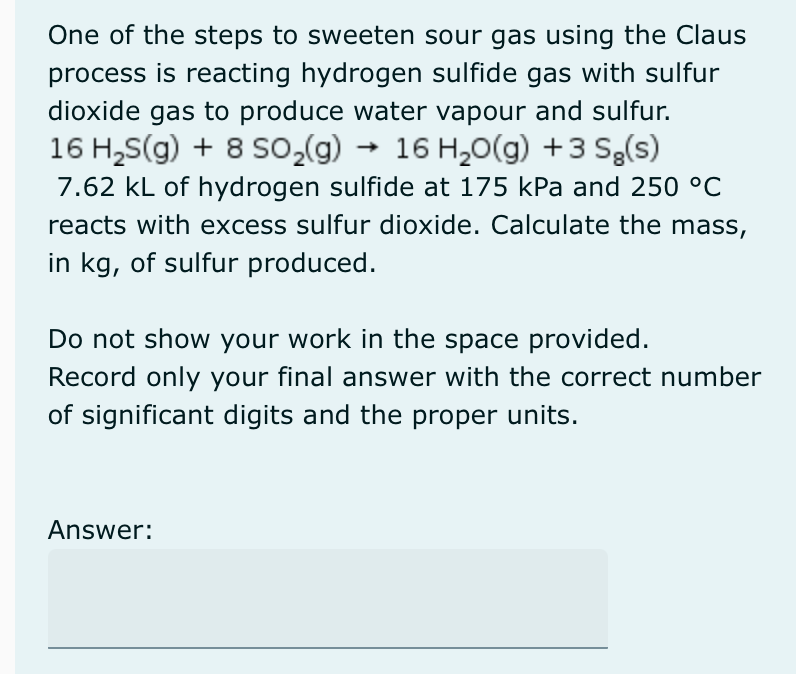One of the steps to sweeten sour gas using the Claus process is reacting hydrogen sulfide gas with sulfur dioxide gas to produce water vapour and sulfur. 16 H₂S(g) + 8 SO₂(g) → 16 H₂O(g) + 3 Sg(s) 7.62 kL of hydrogen sulfide at 175 kPa and 250 °C reacts with excess sulfur dioxide. Calculate the mass, in kg, of sulfur produced. Do not show your work in the space provided. Record only your final answer with the correct number of significant digits and the proper units. Answer:
One of the steps to sweeten sour gas using the Claus process is reacting hydrogen sulfide gas with sulfur dioxide gas to produce water vapour and sulfur. 16 H₂S(g) + 8 SO₂(g) → 16 H₂O(g) + 3 Sg(s) 7.62 kL of hydrogen sulfide at 175 kPa and 250 °C reacts with excess sulfur dioxide. Calculate the mass, in kg, of sulfur produced. Do not show your work in the space provided. Record only your final answer with the correct number of significant digits and the proper units. Answer:
Chemistry: Principles and Reactions
8th Edition
ISBN:9781305079373
Author:William L. Masterton, Cecile N. Hurley
Publisher:William L. Masterton, Cecile N. Hurley
Chapter5: Gases
Section: Chapter Questions
Problem 37QAP: Hydrogen cyanide (HCN) is a poisonous gas. It can be formed by the following reaction:...
Related questions
Question

Transcribed Image Text:One of the steps to sweeten sour gas using the Claus
process is reacting hydrogen sulfide gas with sulfur
dioxide gas to produce water vapour and sulfur.
16 H₂S(g) + 8 SO₂(g) → 16 H₂O(g) + 3 Sg(s)
7.62 kL of hydrogen sulfide at 175 kPa and 250 °C
reacts with excess sulfur dioxide. Calculate the mass,
in kg, of sulfur produced.
Do not show your work in the space provided.
Record only your final answer with the correct number
of significant digits and the proper units.
Answer:
Expert Solution
This question has been solved!
Explore an expertly crafted, step-by-step solution for a thorough understanding of key concepts.
Step by step
Solved in 8 steps with 8 images

Knowledge Booster
Learn more about
Need a deep-dive on the concept behind this application? Look no further. Learn more about this topic, chemistry and related others by exploring similar questions and additional content below.Recommended textbooks for you

Chemistry: Principles and Reactions
Chemistry
ISBN:
9781305079373
Author:
William L. Masterton, Cecile N. Hurley
Publisher:
Cengage Learning

Chemistry for Engineering Students
Chemistry
ISBN:
9781337398909
Author:
Lawrence S. Brown, Tom Holme
Publisher:
Cengage Learning

Introductory Chemistry: A Foundation
Chemistry
ISBN:
9781285199030
Author:
Steven S. Zumdahl, Donald J. DeCoste
Publisher:
Cengage Learning

Chemistry: Principles and Reactions
Chemistry
ISBN:
9781305079373
Author:
William L. Masterton, Cecile N. Hurley
Publisher:
Cengage Learning

Chemistry for Engineering Students
Chemistry
ISBN:
9781337398909
Author:
Lawrence S. Brown, Tom Holme
Publisher:
Cengage Learning

Introductory Chemistry: A Foundation
Chemistry
ISBN:
9781285199030
Author:
Steven S. Zumdahl, Donald J. DeCoste
Publisher:
Cengage Learning

Chemistry & Chemical Reactivity
Chemistry
ISBN:
9781337399074
Author:
John C. Kotz, Paul M. Treichel, John Townsend, David Treichel
Publisher:
Cengage Learning

Chemistry & Chemical Reactivity
Chemistry
ISBN:
9781133949640
Author:
John C. Kotz, Paul M. Treichel, John Townsend, David Treichel
Publisher:
Cengage Learning
